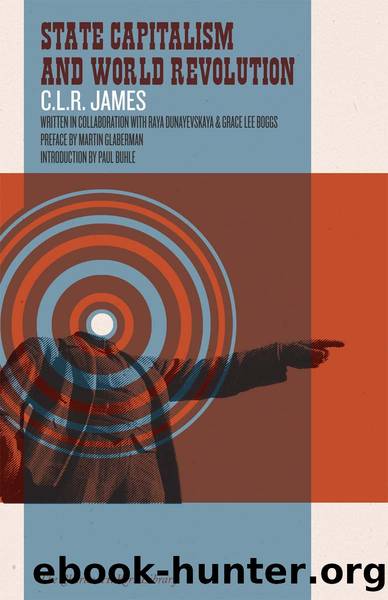State Capitalism and World Revolution by C. L. R. James & Raya Dunayevskaya & Grace Lee Boggs & Martin Glaberman & Paul Buhle

Author:C. L. R. James & Raya Dunayevskaya & Grace Lee Boggs & Martin Glaberman & Paul Buhle
Language: eng
Format: epub
Publisher: PM Press
Published: 2013-08-14T16:00:00+00:00
VI
The Theory of the Party
(A) THE STALINIST theory and practice of the party is the direct result of the Stalinist conception of Plan. The party consists of the elite, the most efficient, the most loyal, the most devoted, etc. The party mobilizes the proletariat, politically, economically and morally, to carry out the Plan. There is here no parallel with the political parties and politics of capitalist competition and bourgeois democracy. In state-capitalism the state becomes capitalistic in the sense of administration, supervision, control against the proletariat. The party forms the state in its own image, which is the reflection of the productive process of state-capitalism. That was the party of Hitler (despite historical differences), that is the party of Stalin.
The Stalinist parties outside Russia function on the same model. Their attitude to the membership and the proletariat is that of an elite leading backward workers. All initiative, policy, direction comes from the Stalinist leaders. Society will be saved if it follows them, defends them, puts its trust in them. Historical circumstances may alter their practice, but in their fundamental conceptions there is no difference whatever between the CP in Russia and the CP in the United States.
(b) Upon the basis of its analysis of state-capitalism and Plan, the Leninist party must form its own revolutionary theory of the party. The party is, in Lenin’s words, based upon the factory but upon the progressive cooperation aspect of the factory: unity, discipline and organization of the working class, in unalterable opposition to the theory and practice of the elite.
Every age has its own specific development of production and its specific social relations. Each separate International has its own separate (and antagonistic) conception of the party which is rooted in its own social base and its conception of its political tasks in relation to that base. Marx’s conception of the party in 1848, the way he organized the First International, carefully explained by him; the organization of the Second International which Lenin accepted as sound up to 1914; the organization of the Third International, all were different and show a dialectical progression. Lenin never conceived of a mass party of two and a half million people before the struggle for power.
The whole of the Stalinist theory and practice of the organization of the party is based upon the administrative-bureaucratic Plan.
Conversely, the revolutionary party expands and develops its own theory on the basis of the vast revolutionary upheavals which are stimulated in the proletariat by the structure of state-capitalism. The European proletariat in Italy, in France, in Spain, and the American proletariat, have already shown us that from the beginning of the social revolution, the proletariat as a whole will be organized to become the state and to manage production. Here concretely is the embodiment of Lenin’s reiterated phrase “to a man” which was impossible of realization in backward Russia in 1917.
Not only does the revolutionary proletariat of our age make its tremendous mass mobilizations. The petty-bourgeoisie does the same as in the Nazi party and the almost overnight creation of the French Rally of millions by de Gaulle.
Download
This site does not store any files on its server. We only index and link to content provided by other sites. Please contact the content providers to delete copyright contents if any and email us, we'll remove relevant links or contents immediately.
| Anarchism | Communism & Socialism |
| Conservatism & Liberalism | Democracy |
| Fascism | Libertarianism |
| Nationalism | Radicalism |
| Utopian |
The Secret History by Donna Tartt(16623)
The Social Justice Warrior Handbook by Lisa De Pasquale(11489)
Thirteen Reasons Why by Jay Asher(7788)
This Is How You Lose Her by Junot Diaz(5772)
Weapons of Math Destruction by Cathy O'Neil(5037)
Zero to One by Peter Thiel(4824)
The Myth of the Strong Leader by Archie Brown(4789)
Promise Me, Dad by Joe Biden(4447)
Beartown by Fredrik Backman(4419)
Stone's Rules by Roger Stone(4415)
How Democracies Die by Steven Levitsky & Daniel Ziblatt(4399)
The Fire Next Time by James Baldwin(4343)
100 Deadly Skills by Clint Emerson(4078)
A Higher Loyalty: Truth, Lies, and Leadership by James Comey(4033)
Rise and Kill First by Ronen Bergman(4012)
The David Icke Guide to the Global Conspiracy (and how to end it) by David Icke(3882)
The Farm by Tom Rob Smith(3872)
Secrecy World by Jake Bernstein(3782)
The Doomsday Machine by Daniel Ellsberg(3731)
